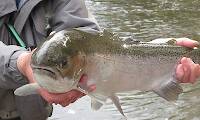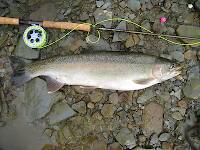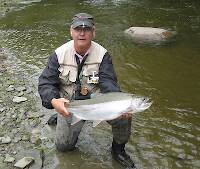
Blue-winged Olives
Baetis
Tiny Baetis mayflies are perhaps the most commonly encountered and imitated by anglers on all American trout streams due to their great abundance, widespread distribution, and trout-friendly emergence habits.
Featured on the forum

Troutnut is a project started in 2003 by salmonid ecologist Jason "Troutnut" Neuswanger to help anglers and
fly tyers unabashedly embrace the entomological side of the sport. Learn more about Troutnut or
support the project for an enhanced experience here.
Troutnut on Jan 16, 2007January 16th, 2007, 10:18 am EST
You posters here have the fortunate habit of bringing up several really interesting ideas in the course of a discussion, each deserving of its own discussion. Once in a while I like to make it official, so from Brad's thread I'm going to steal these two clips:
From Louis (MartinLF):
From Brad (AftonAngler):
I think these are important points. I've been shamefully lax in my own experimentation with these techniques, and often pleasantly surprised when I remember to give it a shot. I've also been meaning to read "Fishing the Dry Fly as a Living Insect," but as usual I'm too booked on projects to find time for many books!
I know that dry fly twitching is an art which suffers at the hands of the dead drift dogma, but I don't have enough experience with it yet myself. I invite everyone to add their experiences.
From Louis (MartinLF):
Several years ago, anchored up in the Gamelands on the West Branch of the Delaware, I watched folks in a driftboat downstream unsuccessfully casting to a fish. When they moved on I pulled anchor and slowly slipped my canoe downstream looking for the rise. Soon I had made several unsuccessful drifts over the same fish when I remembered Bob Clouser telling me to twitch my Green Drake imitation, that browns knew the big bug should be moving. I was certain that I was going to mess it up, producing drag that would leave me pulling anchor and moving on without ever seeing the fish rise again. But twitch I did and a beautiful brown, called from the depths by the struggling emerger, came up and drank in the fly. It was absolute magic.
From Brad (AftonAngler):
I agree that an animated move to a dry fly at certain times will get results when nothing else will. It is really cool to get that kind of feedback from wary fish. To screw with a normally deadly drag free drift takes SAND!
I think these are important points. I've been shamefully lax in my own experimentation with these techniques, and often pleasantly surprised when I remember to give it a shot. I've also been meaning to read "Fishing the Dry Fly as a Living Insect," but as usual I'm too booked on projects to find time for many books!
I know that dry fly twitching is an art which suffers at the hands of the dead drift dogma, but I don't have enough experience with it yet myself. I invite everyone to add their experiences.
Jason Neuswanger, Ph.D.
Troutnut and salmonid ecologist
Troutnut and salmonid ecologist
Trowpa on Jan 17, 2007January 17th, 2007, 5:09 am EST
There is "twitching" and there is "Skittering" I first learned about "skittering" my first time EVER fly fishing when a small hungry trout grabbed my adams as it "skittered" across the water as I dragged it upstream. I later read about it - I think it was in Lee Wulff's "Trout on a Fly" No doubt about it. motion = life. Trout know this too.
-Steve
Martinlf on Jan 17, 2007January 17th, 2007, 6:36 am EST
Wild, pressured browns on a popular nearby spring creek have also eagerly pursued and taken my upside down cdc Baetis (like the caddis in the favorite flies thread, but with a shorter wing; many variations on the shuck are possible, including dyed mallard or woodduck possibly combined with fine antron, krystalflash, or other materials--experiment.) as it began to drag at the end of a drift. I now sometimes fish a similar, even shorter winged fly dry and wet for this hatch, animating it when it seems profitable.
"He spread them a yard and a half. 'And every one that got away is this big.'"
--Fred Chappell
--Fred Chappell
Softhackle on Jan 17, 2007January 17th, 2007, 6:39 am EST
Oh Yes, movement is often important when fly fishing. I attribute the success of the soft-hackles and flymphs to their ability not only to move when being fished (imparted movement) but the soft hackles move in the currents when fished dead drift. I'm sure the trout often think that movement= something alive. This will often trigger a hearty response. I can say I've taken more fish on a moving fly than one fished dead drift.
The definitive work on movement in dry flies is FISHING THE DRY FLY AS A LIVING INSECT. This innovative work by the Late Leonard M. Wright, Jr. completely changed our perspective about fishing dry flies and called our attention to the growing importance of the caddis. Wright was also responsible for debunking old beliefs like "A dry fly must be fished upstream, dead drift."
If you have not read this book, you are missing something.
Mark
The definitive work on movement in dry flies is FISHING THE DRY FLY AS A LIVING INSECT. This innovative work by the Late Leonard M. Wright, Jr. completely changed our perspective about fishing dry flies and called our attention to the growing importance of the caddis. Wright was also responsible for debunking old beliefs like "A dry fly must be fished upstream, dead drift."
If you have not read this book, you are missing something.
Mark
"I have the highest respect for the skilled wet-fly fisherman, as he has mastered an art of very great difficulty." Edward R. Hewitt
Flymphs, Soft-hackles and Spiders: http://www.troutnut.com/libstudio/FS&S/index.html
Flymphs, Soft-hackles and Spiders: http://www.troutnut.com/libstudio/FS&S/index.html
Upnorth2 on Jan 17, 2007January 17th, 2007, 8:41 am EST
Never read the book but stopped dry fishing in the traditional method a long time ago. I could not see and still do for that matter why things have to be done is a static position whether it's fisherman location or the fly on the water.
My first experience was during hex hatch fishing the traditional positiona and the trout taking the flies in a different position. Same applies to fly patterns, I like to use a number of different wing positions and sometimes a twisted body to one side or the other.
My first experience was during hex hatch fishing the traditional positiona and the trout taking the flies in a different position. Same applies to fly patterns, I like to use a number of different wing positions and sometimes a twisted body to one side or the other.
Pbaerman on May 4, 2007May 4th, 2007, 6:24 am EDT
I completely agree with the motion. I was usuccesfully casting up stream and dead drifting a BWO to a group of rising browns. I had a wild hair and decided to sneak upstream of them and proceded to diagonal across the stream and let the fly swing across to my side of the stream. Sure enough the second cast produced a nice 14" er.
Many men go fishing all of their lives without knowing that it is not fish they are after. ~Henry David Thoreau
Shawnny3 on May 5, 2007May 5th, 2007, 3:40 am EDT
A point I'd like to add after reading these posts. I myself have found skittering dries to be a very successful technique, especially in low light. I've even caught (large) fish by standing upstream of a fast run and dangling just my fly in the current, letting it bounce vigorously on the water.
Most anecdotes shared here (including my own) mention using the moving presentation only after covering the water with dead-drifts first. While giving dries movement should probably not be our last resort, I think the order of operations people have mentioned is best: use the least obtrusive technique first. Just because you've caught a few fish by giving action to your fly doesn't mean you should use that technique all the time or on your first cast to a good lie. We all know that giving a fly movement can be effective, but it is also very difficult to do it well, and, when done poorly, a moving presentation almost always puts fish down. It's a risky presentation, and it's smart not to make your riskiest presentation your first.
A moving presentation is especially risky in slow water. For that reason, I find myself twitching dries much more often in fast runs or turbulent pocket water, where I can approach the fish closer and therefore control the fly's movement better. Plus, turbulent water is harder to spoil if you make a bad presentation or two.
Just a few notes of caution...
-Shawn
Most anecdotes shared here (including my own) mention using the moving presentation only after covering the water with dead-drifts first. While giving dries movement should probably not be our last resort, I think the order of operations people have mentioned is best: use the least obtrusive technique first. Just because you've caught a few fish by giving action to your fly doesn't mean you should use that technique all the time or on your first cast to a good lie. We all know that giving a fly movement can be effective, but it is also very difficult to do it well, and, when done poorly, a moving presentation almost always puts fish down. It's a risky presentation, and it's smart not to make your riskiest presentation your first.
A moving presentation is especially risky in slow water. For that reason, I find myself twitching dries much more often in fast runs or turbulent pocket water, where I can approach the fish closer and therefore control the fly's movement better. Plus, turbulent water is harder to spoil if you make a bad presentation or two.
Just a few notes of caution...
-Shawn
Jewelry-Quality Artistic Salmon Flies, by Shawn Davis
www.davisflydesigns.com
www.davisflydesigns.com
Martinlf on May 6, 2007May 6th, 2007, 2:26 pm EDT
Good points, Shawn. Hope all is well with you. I've thought of you passing through Pleasant Gap several times this season, but it's always well after I've left the computer far behind. I'll try to remember some time ahead, and perhaps we can compare flies one day.
"He spread them a yard and a half. 'And every one that got away is this big.'"
--Fred Chappell
--Fred Chappell
Shawnny3 on May 7, 2007May 7th, 2007, 3:41 pm EDT
Thanks, Louis, for thinking of me. Let me know whenever you're in the area. I took my 4-year-old boy out for the first time tonight, and it was a tough time. I was ill-equipped (didn't have big enough sinkers to get his little spinning rod working properly) and was pretty limited in how I could fish (since he can't wade), so I ended up casting really long lines and, on my stupid barbless hooks, I couldn't get any of the fish I hooked controlled well enough to let him bring them in. He was so good and so patient the whole time - I just hope he wasn't too bored to try it again. Ahh, fishing with little ones...
-Shawn
-Shawn
Jewelry-Quality Artistic Salmon Flies, by Shawn Davis
www.davisflydesigns.com
www.davisflydesigns.com
Martinlf on May 8, 2007May 8th, 2007, 2:19 am EDT
Shawn, looking back now with some perspective on my experiences fishing with my girls, (who at ten and fifteen are too big and cool now to go fishing with Dad), they loved being out and didn't care as much about the fish landing details that concerned me at the time. I'd suspect it was the same with your son. But we do learn about what works with them in terms of getting fish in (the last fish I kept my daughter begged to take home to cook. I'm not sure she actually ate any of it). Are there any good rock bass spots near Pleasant Gap? If so, those cooperative little fish are great for kids to learn on. Bluegills work too. There are several books on fishing with kids, but I'd bet you don't need them. The best advice I've heard is keep the outings brief. (I'm afraid that I didn't always follow the best advice, but we all survived, and had some good times.) Best of luck.
"He spread them a yard and a half. 'And every one that got away is this big.'"
--Fred Chappell
--Fred Chappell
Quick Reply
Related Discussions
Topic
Replies
Last Reply
5
Dec 6, 2009
by Bigfly
by Bigfly









